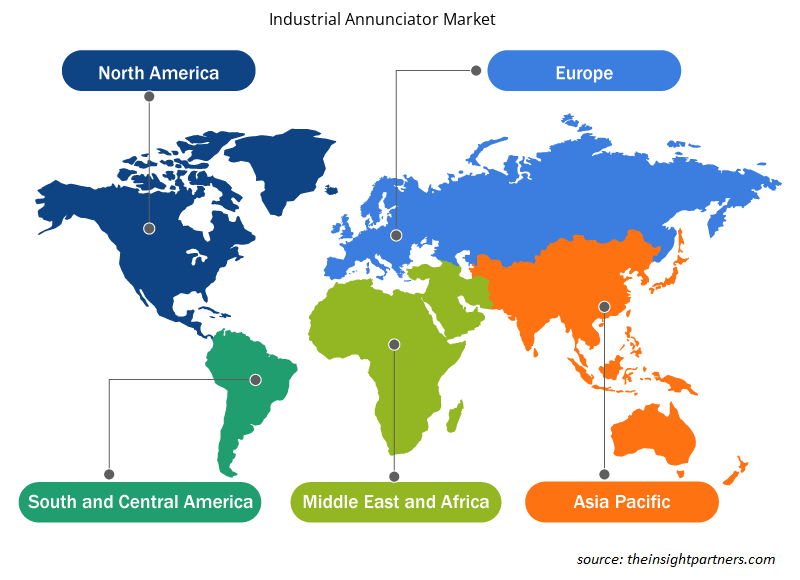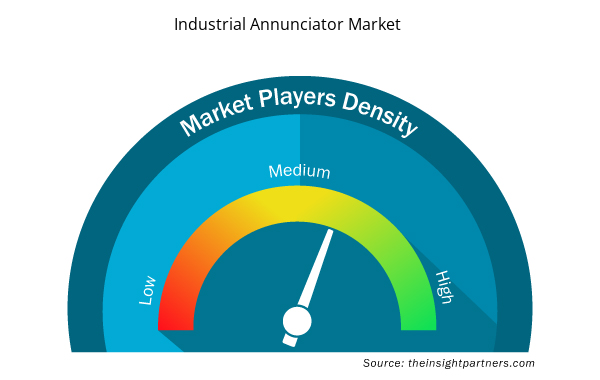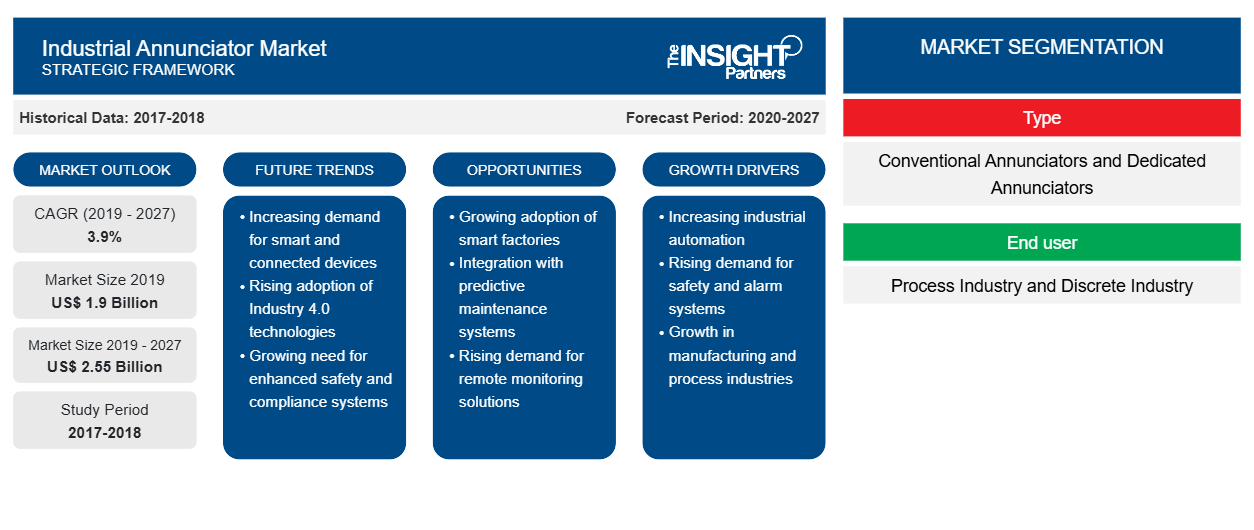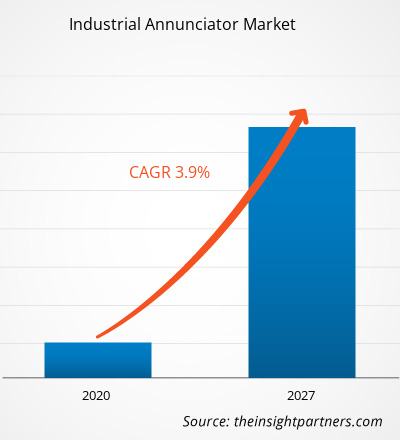2019 年工业报警器市场价值为 19.0088 亿美元,预计到 2027 年将达到 25.4773 亿美元;预计 2019 年至 2027 年的复合年增长率为 3.9%。
多年来,制造和生产设施见证了复杂工业设备和机械的普及率大幅上升,这些设备和机械需要持续监控以确保其无缝运行,以避免灾难性故障。同样,由于投资巨大,飞机、船舶、航空航天和国防车辆等高价值资产需要强大而高效的警报和集中解决方案,以实时提供过程控制信息。因此,工业报警器是一种专门设计的解决方案,有助于无缝监控和监督过程和离散工业中的各种工业流程、设备、资产和运营活动。基于产品设计和功能,如果集中位置发生意外活动或故障,该解决方案会向相关过程控制提供快速警报或警告。因此,与传统的警报或警告系统不同,工业报警器可以显著帮助精确突出显示故障位置,随后转移资源或行动小组,以防止设施或资产内的故障连锁。
预计亚太地区将成为工业报警器市场增长最快的地区。该地区由中国、印度、日本、台湾和韩国等多个发展中国家组成,这些国家/地区的工业数量(包括过程工业和离散工业)正在大幅增长。拥有先进技术的行业数量不断增长,推动了制造商和装配商对工业报警器的需求。该地区的工业部门参与者越来越重视互联技术,这有助于参与者优化生产力,从而增加收入。因此,工业部门对互联技术日益增长的需求被认为是促进报警器发展的重要因素,这正在扩大该地区的工业报警器市场。
定制此报告以满足您的需求
您可以免费定制任何报告,包括本报告的部分内容、国家级分析、Excel 数据包,以及为初创企业和大学提供优惠和折扣
- 获取此报告的关键市场趋势。这个免费样品将包括数据分析,从市场趋势到估计和预测。
COVID-19 疫情对工业报警器市场的影响
持续的全球大流行 COVID-19 继续对几个主要的流程和离散行业造成长期破坏。例如,汽车、钢铁生产、一般制造业、电气和电子行业以及 OEM 市场参与者等众多其他行业都面临着供应链中断的问题。然而,在流程工业中,影响在不同的垂直行业有所不同,例如对航空、石油和天然气以及众多材料行业的影响严重,导致其持续生产量大幅减少。然而,食品和饮料、制药、发电和化学品等行业在不同经济体的大流行期间受到的干扰有限。因此,为尽量减少 COVID-19 的传播而实施的全国性封锁严重扰乱了供应链活动以及多家制造商(尤其是中小企业主)的生产量。此外,有限的生产活动以及对众多控制产品和组件的需求消失预计将在 2020 年大幅萎缩,导致未来几年市场增长急剧下降。
市场洞察
用于管理工厂安全的工业报警器需求增加
报警器与安全停机系统 (SIS) 密切相关;但是,它们的功能并不相似。报警器对于保持处理单元的完整性至关重要。这些系统会提醒操作员注意工厂状况,例如偏离标准操作限值和异常事件,这些情况需要立即采取行动或进行评估。但是,报警器通常与安全无关;它们在支持操作员降低对安全相关系统的要求方面发挥着重要作用,从而提高了工厂的整体安全性。
从核电站的安全壳泄漏到燃料精炼厂爆炸,只有操作员能够及时识别并采取措施应对即将发生的危险,才能避免此类灾难。因此,工业报警器已被多家工厂采用,作为其关键任务安全系统的重要组成部分。
基于类型的市场洞察
工业报警器多年来一直备受瞩目,预计其数量和收入将继续激增。工业报警器需求的不断增长主要归因于发达国家和发展中国家工业数量的增加。此外,随着工业自动化系统的兴起,先进技术和系统的需求和采用率也以惊人的速度飙升。工业报警器市场参与者正致力于开发强大的解决方案来满足客户的需求,这在当前情况下推动了工业报警器市场的发展。根据类型,工业报警器市场分为传统报警器和专用报警器。
基于最终用户的市场洞察
根据最终用户,工业报警器市场分为过程工业和离散工业。由于亚太地区等发展中地区的工业零部件制造商和装配商数量显著增加,预计工业报警器的需求将在预测期内激增。亚太地区的工业零部件制造商和装配商对报警器的好处的认识很高,这为这种设备带来了大量需求,预计将在未来几年支持工业报警器市场的增长。
全球工业报警器市场在全球范围内较为分散,包括发达经济体中知名的知名品牌,以及在亚洲和 MEA 地区等新兴国家运营的大量非正规工业报警器市场参与者。ABB Ltd、AMETEK Inc、Eaton Corporation plc、Ronan Engineering Company、Automation Displays Inc、Dwyer Instruments, Inc、NOTIFIER、Schweitzer Engineering Laboratories, Inc.、Apex Automation Solutions 和 Omniflex 是全球工业报警器市场的主要参与者。
2019年:
AMETEK France 在埃朗库尔市开设了一家技术解决方案中心作为地区总部,以支持其在法国的机电产品和电子仪器业务的增长。此外,该中心的开设旨在成为欧洲市场的创新中心。
2019年:
霍尼韦尔已达成最终协议,将收购 Xtralis,后者是全球领先的吸气式烟雾探测器供应商,同时还提供先进的周界安全技术和视频分析软件。
2018年:
ABB 有限公司宣布在中国上海投资 1.5 亿美元,旨在建设最先进的自动化和柔性机器人工厂。该生产线将专注于机器学习、数字化和协作解决方案,研发团队将专注于人工智能研究。
工业报警器市场区域洞察
Insight Partners 的分析师已详尽解释了预测期内影响工业报警器市场的区域趋势和因素。本节还讨论了北美、欧洲、亚太地区、中东和非洲以及南美和中美洲的工业报警器市场细分和地理位置。

- 获取工业报警器市场的区域特定数据
工业报警器市场报告范围
| 报告属性 | 细节 |
|---|---|
| 2019 年市场规模 | 19亿美元 |
| 2027 年市场规模 | 25.5亿美元 |
| 全球复合年增长率(2019 - 2027) | 3.9% |
| 史料 | 2017-2018 |
| 预测期 | 2020-2027 |
| 涵盖的领域 | 按类型
|
| 覆盖地区和国家 | 北美
|
| 市场领导者和主要公司简介 |
|
市场参与者密度:了解其对商业动态的影响
工业报警器市场正在快速增长,这得益于终端用户需求的不断增长,而这些需求又源于消费者偏好的不断变化、技术进步以及对产品优势的认识不断提高等因素。随着需求的增加,企业正在扩大其产品范围,进行创新以满足消费者的需求,并利用新兴趋势,从而进一步推动市场增长。
市场参与者密度是指在特定市场或行业内运营的企业或公司的分布情况。它表明在给定市场空间中,相对于其规模或总市场价值,有多少竞争对手(市场参与者)存在。
在工业报警器市场运营的主要公司有:
- ABB有限公司
- 阿美特克公司
- 伊顿公司
- 罗南工程公司
- 自动化显示器公司
免责声明:上面列出的公司没有按照任何特定顺序排列。

- 获取工业报警器市场顶级关键参与者概述
工业报警器市场细分:
按类型
- 常规报警器
- 专用报警器
按最终用户
- 离散工业
- 过程工业
公司简介
- ABB有限公司
- 阿美特克公司
- 伊顿公司
- 罗南工程公司
- 自动化显示器公司
- 德怀尔仪器公司
- 通知者
- 施魏策尔工程实验室有限公司
- Apex 自动化解决方案
- 奥米福莱克斯
- 历史分析(2 年)、基准年、预测(7 年)及复合年增长率
- PEST 和 SWOT 分析
- 市场规模价值/数量 - 全球、区域、国家
- 行业和竞争格局
- Excel 数据集



Report Coverage
Revenue forecast, Company Analysis, Industry landscape, Growth factors, and Trends

Segment Covered
This text is related
to segments covered.

Regional Scope
North America, Europe, Asia Pacific, Middle East & Africa, South & Central America

Country Scope
This text is related
to country scope.
常见问题
The discrete industry owing to notable adoption of significant number of electrical machinery, systems, equipment has resulted in their leading market share and is projected to continue to dominate the market during the coming years.
The surge in electrification of industrial process controls and safety system across numerous industry vertical has significantly propelled the growth of the market. IN addition to this, features such as low-cost maintenance of conventional system and durability also has facilitated in the growth of the market in selected industrial sectors.
The Europe region led the industrial annunciator market in 2019 owing to strong considerable demand for maintaining and supervision of industrial system and equipment across its notably large industrial sector and stringent workplace safety regulation.
Trends and growth analysis reports related to Electronics and Semiconductor : READ MORE..
The List of Companies - Industrial Annunciator Market
- ABB Ltd
- AMETEK Inc.
- Eaton Corporation plc
- Ronan Engineering Company
- Automation Displays Inc.
- Dwyer Instruments, Inc.
- NOTIFIER
- Schweitzer Engineering Laboratories, Inc.
- Apex Automation Solutions
- Omniflex
The Insight Partners performs research in 4 major stages: Data Collection & Secondary Research, Primary Research, Data Analysis and Data Triangulation & Final Review.
- Data Collection and Secondary Research:
As a market research and consulting firm operating from a decade, we have published and advised several client across the globe. First step for any study will start with an assessment of currently available data and insights from existing reports. Further, historical and current market information is collected from Investor Presentations, Annual Reports, SEC Filings, etc., and other information related to company’s performance and market positioning are gathered from Paid Databases (Factiva, Hoovers, and Reuters) and various other publications available in public domain.
Several associations trade associates, technical forums, institutes, societies and organization are accessed to gain technical as well as market related insights through their publications such as research papers, blogs and press releases related to the studies are referred to get cues about the market. Further, white papers, journals, magazines, and other news articles published in last 3 years are scrutinized and analyzed to understand the current market trends.
- Primary Research:
The primarily interview analysis comprise of data obtained from industry participants interview and answers to survey questions gathered by in-house primary team.
For primary research, interviews are conducted with industry experts/CEOs/Marketing Managers/VPs/Subject Matter Experts from both demand and supply side to get a 360-degree view of the market. The primary team conducts several interviews based on the complexity of the markets to understand the various market trends and dynamics which makes research more credible and precise.
A typical research interview fulfils the following functions:
- Provides first-hand information on the market size, market trends, growth trends, competitive landscape, and outlook
- Validates and strengthens in-house secondary research findings
- Develops the analysis team’s expertise and market understanding
Primary research involves email interactions and telephone interviews for each market, category, segment, and sub-segment across geographies. The participants who typically take part in such a process include, but are not limited to:
- Industry participants: VPs, business development managers, market intelligence managers and national sales managers
- Outside experts: Valuation experts, research analysts and key opinion leaders specializing in the electronics and semiconductor industry.
Below is the breakup of our primary respondents by company, designation, and region:

Once we receive the confirmation from primary research sources or primary respondents, we finalize the base year market estimation and forecast the data as per the macroeconomic and microeconomic factors assessed during data collection.
- Data Analysis:
Once data is validated through both secondary as well as primary respondents, we finalize the market estimations by hypothesis formulation and factor analysis at regional and country level.
- Macro-Economic Factor Analysis:
We analyse macroeconomic indicators such the gross domestic product (GDP), increase in the demand for goods and services across industries, technological advancement, regional economic growth, governmental policies, the influence of COVID-19, PEST analysis, and other aspects. This analysis aids in setting benchmarks for various nations/regions and approximating market splits. Additionally, the general trend of the aforementioned components aid in determining the market's development possibilities.
- Country Level Data:
Various factors that are especially aligned to the country are taken into account to determine the market size for a certain area and country, including the presence of vendors, such as headquarters and offices, the country's GDP, demand patterns, and industry growth. To comprehend the market dynamics for the nation, a number of growth variables, inhibitors, application areas, and current market trends are researched. The aforementioned elements aid in determining the country's overall market's growth potential.
- Company Profile:
The “Table of Contents” is formulated by listing and analyzing more than 25 - 30 companies operating in the market ecosystem across geographies. However, we profile only 10 companies as a standard practice in our syndicate reports. These 10 companies comprise leading, emerging, and regional players. Nonetheless, our analysis is not restricted to the 10 listed companies, we also analyze other companies present in the market to develop a holistic view and understand the prevailing trends. The “Company Profiles” section in the report covers key facts, business description, products & services, financial information, SWOT analysis, and key developments. The financial information presented is extracted from the annual reports and official documents of the publicly listed companies. Upon collecting the information for the sections of respective companies, we verify them via various primary sources and then compile the data in respective company profiles. The company level information helps us in deriving the base number as well as in forecasting the market size.
- Developing Base Number:
Aggregation of sales statistics (2020-2022) and macro-economic factor, and other secondary and primary research insights are utilized to arrive at base number and related market shares for 2022. The data gaps are identified in this step and relevant market data is analyzed, collected from paid primary interviews or databases. On finalizing the base year market size, forecasts are developed on the basis of macro-economic, industry and market growth factors and company level analysis.
- Data Triangulation and Final Review:
The market findings and base year market size calculations are validated from supply as well as demand side. Demand side validations are based on macro-economic factor analysis and benchmarks for respective regions and countries. In case of supply side validations, revenues of major companies are estimated (in case not available) based on industry benchmark, approximate number of employees, product portfolio, and primary interviews revenues are gathered. Further revenue from target product/service segment is assessed to avoid overshooting of market statistics. In case of heavy deviations between supply and demand side values, all thes steps are repeated to achieve synchronization.
We follow an iterative model, wherein we share our research findings with Subject Matter Experts (SME’s) and Key Opinion Leaders (KOLs) until consensus view of the market is not formulated – this model negates any drastic deviation in the opinions of experts. Only validated and universally acceptable research findings are quoted in our reports.
We have important check points that we use to validate our research findings – which we call – data triangulation, where we validate the information, we generate from secondary sources with primary interviews and then we re-validate with our internal data bases and Subject matter experts. This comprehensive model enables us to deliver high quality, reliable data in shortest possible time.


 获取此报告的免费样本
获取此报告的免费样本